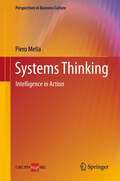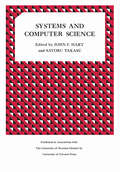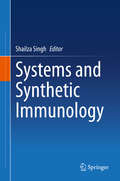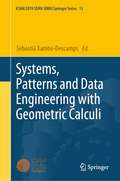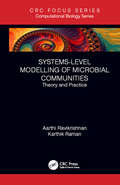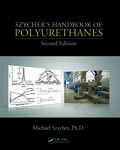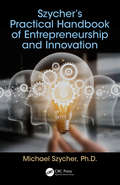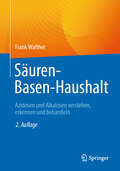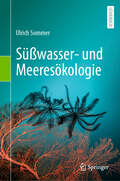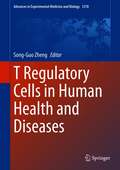- Table View
- List View
Systems Thinking for Social Change: A Practical Guide to Solving Complex Problems, Avoiding Unintended Consequences, and Achieving Lasting Results
by David Peter StrohConcrete guidance on how to incorporate systems thinking in problem solving, decision making, and strategic planning―for everyone! <p><p>Donors, leaders of nonprofits, and public policy makers usually have the best of intentions to serve society and improve social conditions. But often their solutions fall far short of what they want to accomplish and what is truly needed. Moreover, the answers they propose and fund often produce the opposite of what they want over time. We end up with temporary shelters that increase homelessness, drug busts that increase drug-related crime, or food aid that increases starvation. <P><P>How do these unintended consequences come about and how can we avoid them? By applying conventional thinking to complex social problems, we often perpetuate the very problems we try so hard to solve, but it is possible to think differently, and get different results. <P><P>Systems Thinking for Social Change enables readers to contribute more effectively to society by helping them understand what systems thinking is and why it is so important in their work. It also gives concrete guidance on how to incorporate systems thinking in problem solving, decision making, and strategic planning without becoming a technical expert.
Systems Thinking for Sustainability Education in Business Schools (SpringerBriefs in Complexity)
by Hassan Qudrat-UllahThis book delves into the current state and future prospects of systems thinking and sustainability education within business schools. It meticulously examines the trends and drivers shaping the demand and supply of such education, along with the implications and challenges it presents for various stakeholders and society at large. Strategic recommendations and suggestions are provided to elevate and propel systems thinking and sustainability education in business schools, outlining a visionary roadmap for the future. Furthermore, the book explores the intersectionality of sustainability and diversity in business education, offering examples and cases of visionary and innovative initiatives and projects in the field. Distinguished by special features such as illustrations, the book offers a comprehensive and integrative overview of the current landscape and future trajectories of systems thinking and sustainability education in business schools. The primary benefit for readers lies in gaining a deeper and broader understanding of systems thinking and sustainability education in business schools. It equips them with the knowledge to apply systems thinking and sustainability principles and tools to tackle the complex and wicked problems of the twenty-first century. Additionally, the book aims to inspire and inform business schools and their stakeholders to embrace and enhance systems thinking and sustainability education in their curricula and pedagogy, contributing to the advancement of sustainability and systems thinking in both business and society.
Systems Thinking: From Heresy to Practice
by Keivan Zokaei John Seddon Brendan O'DonovanSystems Thinking is a topic which is at the forefront of how we think about management in the Public Sector and Service Industries. This collection from leading thinkers in the field takes a case study approach to a variety of issueswhich encompass topics such as Banking, Electrical Distribution, Manufacturing andAdult Social Care. "
Systems Thinking: Intelligence in Action
by Piero MellaThe core belief underlying this book is that the most useful and effective models to strengthen our intelligence are system ones, developed following the logic of Systems Thinking. Such models can explore complexity, dynamics, and change, and it is the author's view that intelligence depends on the ability to construct models of this nature. The book is designed to allow the reader not only to acquire simple information on Systems Thinking but above all to gradually learn the logic and techniques that make this way of thinking an instrument for the improvement of intelligence. In order to aid the learning and practice of the Systems Thinking discipline, the author has abandoned a rigid formal language for a more discursive style. He writes in the first person, with an ample number of citations and critical analyses, and without ever giving in to the temptation to use formal mathematics.
Systems Thinking: Managing Chaos And Complexity: A Platform For Designing Business Architecture
by Jamshid GharajedaghiSystems Thinking, Third Edition combines systems theory and interactive design to provide an operational methodology for defining problems and designing solutions in an environment increasingly characterized by chaos and complexity. This new edition has been updated to include all new chapters on self-organizing systems as well as holistic, operational, and design thinking. <p><p> The book covers recent crises in financial systems and job markets, the housing bubble, and environment, assessing their impact on systems thinking. A companion website is available at interactdesign.com. <p> This volume is ideal for senior executives as well as for chief information/operating officers and other executives charged with systems management and process improvement. It may also be a helpful resource for IT/MBA students and academics.
Systems Ultra: Making Sense of Technology in a Complex World
by Georgina VossA TOOLBOX FOR COMPREHENDING — AND CHANGING — THE WORLDSystems Ultra explores how we experience complex systems: the mesh of things, people, and ideas interacting to produce their own patterns and behaviours.What does it mean when a car which runs on code drives dangerously? What does massmarket graphics software tell us about the workplace politics of architects? And, in these human-made systems, which phenomena are designed, and which are emergent? In a world of networked technologies, global supply chains, and supranational regulations, there are growing calls for a new kind of literacy around systems and their ramifications. At the same time, we are often told these systems are impossible to fully comprehend and are far beyond our control.Drawing on field research and artistic practice around the industrial settings of ports, air traffic control, architectural software, payment platforms in adult entertainment, and car crash testing, Georgina Voss argues that complex systems can be approached as sites of revelation around scale, time, materiality, deviance, and breakages. With humour and guile, she tells the story of what &‘systems&’ have come to mean, how they have been sold to us, and the real-world consequences of the power that flows through them.Systems Ultra goes beyond narratives of technological exceptionalism to explore how we experience the complex systems which influence our lives, how to understand them more clearly, and, perhaps, how to change them.
Systems and Computer Science: Proceedings of a Conference held at the University of Western Ontario September 10-11, 1965
by John Hart Satoru TakasuThis book presents the papers delivered at the Conference on Systems and Computer Science held at the University of Western Ontario in September 1965. The primary purposes of the Conference were the promotion of research and the development of the teaching of computer science in Canadian universities. The papers focus attention on some of the concepts of Computer Science as a new field of study and at the same time provide a background for scientists looking at the subject for the first time. The chief developments in computer science have been concerned with the "applied" rather than the "pure" areas of the field: numerical analysis, applied statistics and operations research, and data processing. But there is something more to computers than the physical components and this book represents an attempt to correct the imbalance between "applied" and "pure" by drawing attention to certain theoretical aspects of computer and information science. Among the topics discussed are the theory of finite and infinite automata, aspects of formal language theory, heuristic and non-heuristic approaches to theorem proving and the mathematical formulation of the theory of general systems. There are also references to the problems of machine design, to software systems including higher-level languages, to multiple control computer models and to applied systems. This collection of papers will appeal first to graduate students and professors in Computer Science. It will also be of interest to computer scientists in industry and in government and university research groups and to the scientific public interested in discovering some of the principal ingredients and directions of the computer and information sciences.
Systems and Implemented Technologies for Data-Driven Innovation, addressing Data Spaces and Marketplaces Semantic Interoperability Needs: i3-MARKET Series - Part II: Data Economy, Models, Technologies and Solutions (River Publishers Series in Computing and Information Science and Technology)
by Martín Serrano Achille Zappa Waheed Ashraf Pedro Maló Márcio Mateus Edgar Fries Iván Martínez Alessandro Amicone Justina Bieliauskaite Marina CugurraIn the second i3-MARKET series book we review the basic technological principles, software best practices, and standards for implementing and deploying data spaces and data marketplaces. The book provides a definition for data-driven society as: The process to transform data production into data economy for the people using the emerging technologies and scientific advances in data science to underpin the delivery of data economic models and services. This book further discusses why data spaces and data marketplaces are the focus in today’s data-driven society as the trend to rapidly transform the data perception in every aspect of our activities. In this book, technology assets that are designed and implemented following the i3-MARKET backplane reference implementation (WebRI) that uses open data, big data, IoT and AI design principles is introduced. Moreover, the series of software assets grouped as sub-systems and composed by software artefacts are included and explained in full. Further, we describe i3-MARKET backplane tools and how these can be used for supporting marketplaces and its components including details of available data assets. Next, we provide descriptions of solutions developed in i3-MARKET as an overview of the potential for being the reference open-source solution to improve data economy across different data marketplaces.
Systems and Innovation Research in Transition: Research Questions and Trends in Historical Perspective (Sustainability and Innovation)
by Rainer Walz Jakob EdlerIn the last decades it has become more and more imperative for our societies, and for decision makers in all areas of society, to understand the dynamics through which innovation systems develop and through which socio-technical systems transform themselves. As both innovation and transformation are strongly intertwined, it has equally become imperative to analyse their dynamics as well as their interplay. This open access volume reflects on the research fields that have developed in the last five decades to do exactly that. It defines and delineates research on systems and innovation as encompassing the scientific study of, first, the conditions, dynamics and impacts associated with the generation and uptake of innovations and, second, the development and transformation of functional systems satisfying essential needs such as the provision of energy or water. Further, the area of Systems and Innovation Research (SIR) is characterised by problem and stakeholder oriented research. We chose five decades as time frame because we noted that roughly 50 years ago a number of research institutes dedicated to SIR were founded and the SIR area started to grow significantly. We present a systematic history of nine selected fields within the area of SIR (Innovation policy, Innovation indicators, Foresight, Policy Evaluation, Technology Assessment, Production Paradigms, Renewable Energies, Energy Efficiency, Water Use). We also present a conceptual framework to understand the processes by which the research fields have developed. This allows to draw general lessons as to what drives fields throughout their development and how their role vis-à-vis policy, businesses and societies changes over time. It also allows to speculate about future challenges and trends in the SIR area. This is important because, if anything, the need to govern transformation through innovation will further grow in the future, and with it the need to understand the underlying dynamics.
Systems and Synthetic Biology
by Vikram Singh Pawan K. DharThis textbook has been conceptualized to provide a detailed description of the various aspects of Systems and Synthetic Biology, keeping the requirements of M. Sc. and Ph. D. students in mind. Also, it is hoped that this book will mentor young scientists who are willing to contribute to this area but do not know from where to begin. The book has been divided into two sections. The first section will deal with systems biology - in terms of the foundational understanding, highlighting issues in biological complexity, methods of analysis and various aspects of modelling. The second section deals with the engineering concepts, design strategies of the biological systems ranging from simple DNA/RNA fragments, switches and oscillators, molecular pathways to a complete synthetic cell will be described. Finally, the book will offer expert opinions in legal, safety, security and social issues to present a well-balanced information both for students and scientists.
Systems and Synthetic Immunology
by Shailza SinghSystems and Synthetic Immunology focuses on the similarities between biology and engineering at the systems level, which are important for applying engineering theories to biology problems. With the advent of new genomic techniques, there are numerous systematic investigations underway in the scientific world. This volume highlights techniques that can be used to effectively combine two of the most essential biological fields - Systems Biology and Synthetic Immunology.The respective chapters discuss the role of synthetic immunology in biotechnology, production of biomaterials, and their use in vaccine delivery. Further topics include the importance of cytokines; the use of genomic engineering tools in immunotherapy; immunosensors; nanotherapeutics; and bioinformatics tools in biomedical applications. Given its scope, the book offers readers an up-to-date and comprehensive review of this unique and dynamic field of research.
Systems of Life: Biopolitics, Economics, and Literature on the Cusp of Modernity (Forms of Living)
by Richard A. Barney and Warren MontagSystems of Life offers a wide-ranging revaluation of the emergence of biopolitics in Europe from the mid– eighteenth to the mid–nineteenth century. In staging an encounter among literature, political economy, and the still emergent sciences of life in that historical moment, the essays collected here reopen the question of how concepts of animal, vegetable, and human life, among other biological registers, had an impact on the Enlightenment project of thinking politics and economics as a joint enterprise. The volume’s contributors consider politics, economics, and the biological as distinct, semi-autonomous spheres whose various combinations required inventive, sometimes incomplete, acts of conceptual mediation, philosophical negotiation, disciplinary intervention, or aesthetic representation.
Systems, Patterns and Data Engineering with Geometric Calculi (SEMA SIMAI Springer Series #13)
by Sebastià Xambó-DescampsThe intention of this collection agrees with the purposes of the homonymous mini-symposium (MS) at ICIAM-2019, which were to overview the essentials of geometric calculus (GC) formalism, to report on state-of-the-art applications showcasing its advantages and to explore the bearing of GC in novel approaches to deep learning. The first three contributions, which correspond to lectures at the MS, offer perspectives on recent advances in the application GC in the areas of robotics, molecular geometry, and medical imaging. The next three, especially invited, hone the expressiveness of GC in orientation measurements under different metrics, the treatment of contact elements, and the investigation of efficient computational methodologies. The last two, which also correspond to lectures at the MS, deal with two aspects of deep learning: a presentation of a concrete quaternionic convolutional neural network layer for image classification that features contrast invariance and a general overview of automatic learning aimed at steering the development of neural networks whose units process elements of a suitable algebra, such as a geometric algebra. The book fits, broadly speaking, within the realm of mathematical engineering, and consequently, it is intended for a wide spectrum of research profiles. In particular, it should bring inspiration and guidance to those looking for materials and problems that bridge GC with applications of great current interest, including the auspicious field of GC-based deep neural networks.
Systems-Level Modelling of Microbial Communities: Theory and Practice (Focus Computational Biology Series)
by Karthik Raman Aarthi RavikrishnanSystems-Level Modelling of Microbial Communities: Theory and Practice introduces various aspects of modelling microbial communities and presents a detailed overview of the computational methods which have been developed in this area. This book is aimed at researchers in the field of computational/systems biology as well as biologists/experimentalists studying microbial communities, who are keen on embracing the concepts of computational modelling. The primary focus of this book is on methods for modelling interactions between micro-organisms in a community, with special emphasis on constraint-based and network-based modelling techniques. A brief overview of population- and agent-based modelling is also presented. Lastly, it covers the experimental methods to understand microbial communities, and provides an outlook on how the field may evolve in the coming years.
Systemverfahrenstechnik in der Ingenieurspraxis: Beherrschung von Prozessen, Gefährdungen und Reinheitskriterien
by Bernd EbertDas Buch behandelt die für das Optimum verfahrenstechnischer Prozesse unerlässliche System-Betrachtung. Diese sollte nicht nur für den „reinen“ Prozess erfolgen, sondern für den gesamten Lebenszyklus technischer Anlagen – vom Entwurf eines Prozesses bis zur Optimierung im laufenden Betrieb. Dabei kommt es nicht nur auf den Normalbetrieb an (wie häufig bei Simulationen betrachtet), sondern auch auf An- und Abfahrprozesse, das Havarie-/Störungsverhalten der Prozesse, die Reinigungsabläufe, Sicherheitsmaßnahmen usw. Geeignete Analyse- und Betrachtungsmethoden werden dazu vorgestellt, die sich in langjähriger Planungs- und Betriebspraxis herausgebildet haben. Hierzu zählen u.a. Risikoanalysen, Zeitdynamik- und Zuverlässigkeitsmethoden; deren theoretischer Ansatz wird mit ihrer praktischen Anwendbarkeit verbunden. Auch Aspekte wie Industrie 4.0 und Prozessänderungen bei laufenden Anlagen werden betrachtet. Damit soll ein Beitrag sowohl für die Ingenieurausbildung, die technische Betriebsbetreuung als auch für die Projektabwicklung geleistet werden.
Szycher's Dictionary of Medical Devices
by Michael SzycherFROM THE PREFACEThe field of medical devices represents one of the most advanced technological areas in the United States. In 1991, over 12 million Americans had at least one medical device; fixation devices had the highest incidence, followed by contact lens use and lens implants and, lastly, artificial joints. The public has come to expect that medical devices will alleviate maladies and/or conditions that were not treatable fifty years ago. It is hard to believe that the first pacemaker was invented in the 1950s, the first artificial heart valve in 1952, and the first artificial hip replacement was performed in 1954. In 1992, the medical device industry exported a total of $6.9 billion, while the country imported a total of $3.9 billion, representing a $3.0 billion trade surplus. Medical devices are among the most regulated products in the world. The FDA maintains a constant vigil over medical device manufacturers and importers; even medical device definitions are subject to official scrutiny. Title 21 of the Code of Federal Regulations publishes these definitions, but the definitions are spread over several medical specialty areas and are, thus, difficult to find. This book attempts to bring a measure of order by providing an alphabetical listing of officially defined devices.
Szycher's Handbook of Polyurethanes
by Michael SzycherA practical handbook rather than merely a chemistry reference, Szycher's Handbook of Polyurethanes, Second Edition offers an easy-to-follow compilation of crucial new information on polyurethane technology, which is irreplaceable in a wide range of applications. This new edition of a bestseller is an invaluable reference for technologists, marketer
Szycher’s Practical Handbook of Entrepreneurship and Innovation
by Michael SzycherThis practical and comprehensive handbook offers step-by-step instruction, guiding entrepreneurs of innovative technology startups all the way from idea to profitability. With its easy-to-follow format aimed at both experienced as well as novice entrepreneurs, this book covers all technical, financial, legal, and governmental hurdles facing startups. It discusses common causes of business failure and points out the pitfalls to avoid in getting innovative technology successfully to market.
Säuren-Basen-Haushalt: Azidosen und Alkalosen verstehen, erkennen und behandeln
by Frank WaltherDieses Buch beinhaltet Grundlagen, Diagnostik und Therapie von Störungen des Säuren-Basen-Haushalts.Wer sich dafür interessiert, wie eine diabetische Ketoazidose entsteht, wie man sie behandelt, welchen Stellenwert die Therapie mit Puffersubstanzen bei Störungen des Säuren-Basen-Haushaltes hat, wie sich eine Hypothermie auf den Säuren-Basen-Haushalt auswirkt, was eine posthyperkapnische Alkalose ist, oder wer wissen möchte, wodurch sich BE- und Standardbikarbonat-Wert im Säuren-Basen-Status unterscheiden, findet die Erklärungen und Grundlagen dafür und noch etliches mehr in diesem Buch. Neben Kapiteln, die sich mit den weitgehend unveränderlichen Grundlagen und Grundsätzen der therapeutischen Möglichkeiten beschäftigen bzw. für Bereiche mit noch unzureichender Evidenzgrundlage die aktuell führenden Expertenmeinungen wiedergeben, werden zur Veranschaulichung 12 klinische Fälle präsentiert, an deren Beispiel die diagnostische Vorgehensweise bei unterschiedlichen Säuren-Basen-Störungen und die klinischen bzw. therapeutischen Schlussfolgerungen erläutert werden. Ziel des Buches ist die Vermittlung von fundiertem und doch praxisrelevanten, am Krankenbett einsetzbaren Wissen auf der Grundlage des Wissens aus der Biochemie und Physiologie-Ausbildung des Physikums. Es wendet sich an Ärztinnen und Ärzte verschiedener Facharztausbildungen sowie Medizinstudentinnen und -studenten.
Säuren-Basen-Haushalt: Azidosen und Alkalosen verstehen, erkennen und behandeln
by Frank WaltherDieses Buch beinhaltet Grundlagen, Diagnostik und Therapie von Störungen des Säuren-Basen-Haushalts. Wer sich dafür interessiert, wie eine diabetische Ketoazidose entsteht, wie man sie behandelt, welchen Stellenwert die Therapie mit Puffersubstanzen bei Störungen des Säuren-Basen-Haushaltes hat, wie sich eine Hypothermie auf den Säuren-Basen-Haushalt auswirkt, was eine posthyperkapnische Alkalose ist, oder wer wissen möchte, wodurch sich BE- und Standardbikarbonat-Wert im Säuren-Basen-Status unterscheiden, findet die Erklärungen und Grundlagen dafür und noch etliches mehr in diesem Buch. Neben Kapiteln, die sich mit den weitgehend unveränderlichen Grundlagen und Grundsätzen der therapeutischen Möglichkeiten beschäftigen bzw. für Bereiche mit noch unzureichender Evidenzgrundlage die aktuell führenden Expertenmeinungen wiedergeben, werden zur Veranschaulichung 12 klinische Fälle präsentiert, an deren Beispiel die diagnostische Vorgehensweise bei unterschiedlichen Säuren-Basen-Störungen und die klinischen bzw. therapeutischen Schlussfolgerungen erläutert werden. Ziel des Buches ist die Vermittlung von fundiertem und praxisrelevanten, am Krankenbett einsetzbaren Wissen auf der Grundlage des Wissens aus der Biochemie und Physiologie-Ausbildung des Physikums. Es wendet sich an Ärztinnen und Ärzte verschiedener Facharztausbildungen sowie Medizinstudentinnen und -studenten. In der 2. Auflage wurde das Buch sorgfältig überarbeitet und aktualisiert und um neue Informationen ergänzt, z. B. zum Kalzium-Phosphat-Haushalt und zur 2022 erschienenen neuen Leitlinie für die Behandlung der diabetischen Ketoazidose im Kindesalter.
Sífilis: otra enfermedad que nos llegó de Europa la medicina y la sífilis en el Viejo Mundo
by Naranjo PlutarcoEntre marzo y abril de 1495, en Nápoles, se desató una terrible epidemia de sífilis que luego se propagó a Francia y desde aquí al resto de Europa. Durante los primeros cuarenta años de la epidemia nadie puso en duda el sitio dónde se originó y luego cuál país se convirtió en el foco de diseminación del mal venéreo que comenzó a llamarse el morbo gálico. Inesperadamente ciertos autores poco escrupulosos, del siglo XVI, afirmaron que la sífilis era originaria de América, continente al cual, sin quererlo, Europa había "exportado" todas las pestes del Viejo Mundo. Existe un dicho popular: "favor con favor se paga", parafraseándolo en sentido inverso, parecería que se trataba de demostrar que hubo un intercambio epidémico y que en "reciprocidad" de las enfermedades que Europa envió a América, ésta exportó al Viejo Continente la sífilis.
Süßwasser- und Meeresökologie
by Ulrich SommerSüßwasser- und Meeresökologie bietet eine umfassende Einführung in die aquatische Ökologie, indem es die Fachgebiete Limnologie und biologische Ozeanographie integriert. Strukturiert wie allgemeine Ökologie-Lehrbücher, entwickelt es den Gegenstand von grundlegenden Einheiten wie Individuen bis hin zu komplexen Ökosystemen und globalen Biogeochemieprozessen. Das Buch hebt sich durch seine ausgewogene Auswahl an Beispielen aus Süßwasser- und Meeresstudien hervor, die Feldbeobachtungen, experimentelle Studien und Modelle umfassen. Es bietet nicht nur Einblicke in aktuelle Forschungsentwicklungen, sondern würdigt auch klassische Studien, die die theoretischen Grundlagen des Fachgebiets gelegt haben. Süßwasser- und Meeresökologie ist somit nicht nur ideal für grundlegende Kurse in biologischer Ozeanographie, Limnologie und Ökologie geeignet, sondern bietet auch fortgeschrittenen Studierenden, Lehrkräften und Wissenschaftlern mit unterschiedlichem Erfahrungshintergrund einen wertvollen Zugang zu den aquatischen Wissenschaften.
T Cell Activation: Methods and Protocols (Methods in Molecular Biology #2904)
by Björn-Philipp DiercksThis volume provides detailed, up-to-date methods used in basic and applied research on T-cell activation. Chapters explore the fundamentals in T-cell biology a board range cutting-edge techniques from initial Ca2+ live-cell imaging to downstream effector functions in autoimmune disease. Written in the format of the highly successful Methods in Molecular Biology series, each chapter includes an introduction to the topic, lists necessary materials and reagents, includes tips on troubleshooting and known pitfalls, and step-by-step, readily reproducible protocols. Authoritative and cutting-edge, T- cell activation: Methods and Protocols will be an indispensable protocol collection for researchers studying T-cell activation in inflammation and immunity.
T Cell Protocols
by Gennaro De LiberoWith a wide variety of investigative approaches, T cell immunology is a vital and open field of study. In T Cell Protocols, Second Edition, an international panel of experts contribute fully updated classic protocols as well as newly established novel techniques for the study of T lymphocyte biology. Written in the highly successful Methods in Molecular BiologyTM series format, the chapters in this volume provide brief introductions to the topics, lists of the necessary materials and reagents, step-by-step, readily reproducible laboratory protocols, and Notes sections which collect expert tips on troubleshooting and avoiding known pitfalls. Up-to-date and easy to use, T Cell Protocols, Second Edition is an ideal guide for young investigators new to the complex field of immunology as well as a valuable, concise resource for experienced scientists searching for clear, efficacious descriptions of novel methods.
T Regulatory Cells in Human Health and Diseases (Advances in Experimental Medicine and Biology #1278)
by Song-Guo ZhengThis book addresses one of the major challenges of immunology today that is being directed to the translation of the rapidly emerging volume of basic science contributions of immunology to clinical medicine. In so doing, the book systemically introduces and discusses concepts, classifications, phenotypic and functional descriptions of regulatory T (Treg) cells in health and disease. The authors of the 15 chapters were selected from among the most qualified experts in the field of Treg cell research who provide a comprehensive overview of Treg cells and their biology in the ensuing chapters.The beginning chapters provide a useful contemporary classification of Treg cell populations and then progress to chapters that explore basic mechanisms of Treg cell function and epigenetic control. In addition to descriptions of typical CD4+ Foxp3+ cells, other chapters provide detailed presentations of Treg subsets such as CD8+ Tregs and IL-10-producing Tr1 cells. The differences of various Treg subsets, as well as circulating and resident Treg cell populations, are next compared. Importantly, the next chapters provide the clinical correlation of Treg cells with autoimmune diseases, inflammatory diseases, metabolic diseases, cancer and organ transplantation and progress to chapters that highlight emerging innovative technology including nanoparticle-Treg cells and their translational values. In summary, the book will provide a valuable resource not only for graduate students and researchers in the fields of immunology, cell biology and translational medicine but also for all others interested in learning more about Treg cells and their application in human health and disease.



